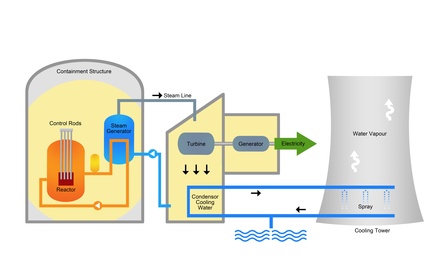Nuclear Power Illustrated
Scientists often use graphs to highlight the benefits and risks of nuclear energy as compared to other commonly used fuels. One of the most common graphs will fully outline the advantages and disadvantages of everything from fossil fuel use to hydro power.
Fossil Fuels
Coal and oil have been used for generations to heat homes, power locomotives and to create electrical power. The electricity produce by fossil fuel-powered pants is transmitted through huge commercial grids where lines carry the power into homes and businesses in the area on demand.

The grid systems have become sophisticated with power grids tying together into one huge source of electrical energy.
This allows power companies to better manage their loads during high demand hours or on days when extreme heat or cold leads to high energy consumption by customers.
Natural gas and oil are often discussed together. Both come from the earth and drilling oil releases pockets of natural gas. Both have good distribution systems in place but both are rather expensive when used for energy production.
The price of oil swings wildly based on regional conflicts, political unrest, supply and demand. As oil is used to produce gasoline for our automobiles, the rising cost of oil is always of great concern for consumers.
When it comes to natural gas, there are safety concerns about storage facilities and gas pipelines. Most of the opposition is from environmentalists concerned about the effects of storing and transmitting explosive natural gas.
For the public, natural gas is a clean fuel for heating and is often preferred for cooking and water heaters. In some areas of the country, natural gas is fully available while in others only propane gas in tanks can be used.
Coal is one of the oldest fossil fuels used to produce electricity and the coal in the U.S. has been mined for generations. The best grade of coal, anthracite, has been depleted.
Most coal mines today are producing bituminous coal which burns faster and process more contaminants than the harder anthracite. Both coal and oil are not renewable or sustainable resources. Both produce a significant amount of pollution in both air and water.
Though coal is usually moved by rail, problems with transporting oil have been leaking oil tankers and leaks from oil wells drilled into ocean beds. Leaking oil contaminates what it touches and kills fish, plants and coral reefs in the ocean; oil reaching the coastline kills birds and destroys wetland ecosystems.
Alternative Energy
One of the current favorites is wind energy. Huge turbines mounted on tall steel towers are views as graceful by some people while others thing the towers are eyesores.
Wind is free in areas where it's available. In the U.S., there are many states where wind energy works quite well. Wind energy is a good source for pumping water for irrigation and the technology is suitable for rural areas.
The size of the generators limits the amount of energy one turbine can produce so a wind farm is composed of many wind towers. Wind energy is climate dependent and there are concerns about the effect the huge turning blades might have on local bird species.
Solar power has been in the news frequently in the past 2-3 years. Like wind, sunlight is free when it's available. Costs of the materials needed to install a solar energy system have declined as mass production has increased.
Solar power is mostly limited to the southern states in the U.S. though there are many other countries where solar power is a good option. Thought solar power has a sustainable energy source, placing the collection panels needed for solar power can take up quite a bit of space.
The amount of land or surface area for solar panels is quite large for the small amount of energy produced by one panel. Hydroelectric power is unlikely to expand beyond the current dam system already in place. Elevation of the water is critical to creating electricity from the force of falling water.
Huge dams built in the past have mostly used up the good areas where hydroelectric power is a sensible option. Studies have shown damage to fish species have been caused by the building dams and waterways for hydroelectric power plants. When the huge dams were built there were no environmental protection agencies to study potential effect on wildlife and fish.
The biggest problem with hydroelectric power is the dams lead to flooding in storm season of land that would not otherwise flood. A break the dam can destroy billions of dollars in property downstream and be responsible for deaths as well.
Summary
Graphs of nuclear energy most often highlight the costs and benefits of nuclear power as compared to fossil fuels and to popular alternative energy sources.
The lack of pollutants, the low cost of fuel needed and even the number of incidents or accidents reported may be included on graphs of nuclear energy.
